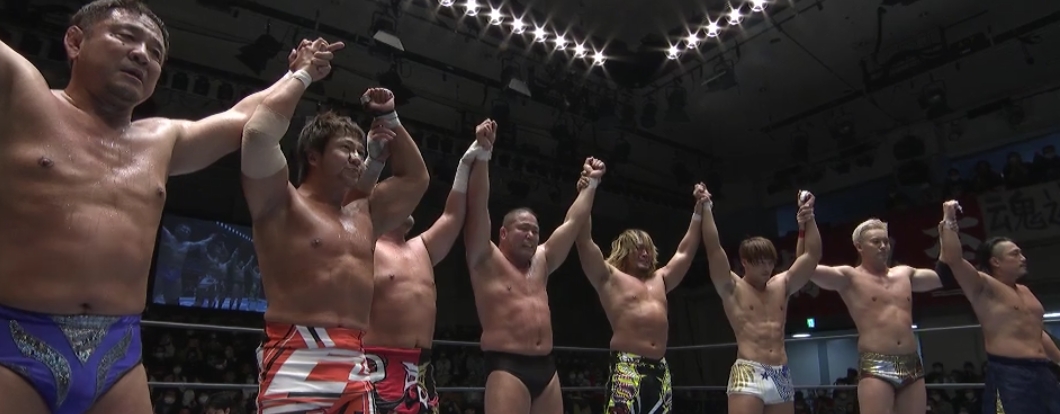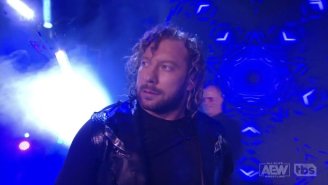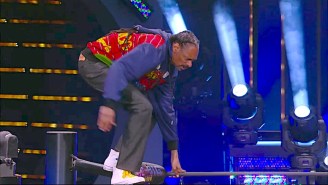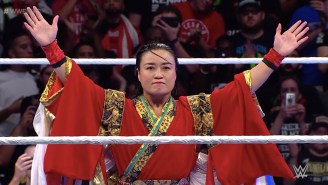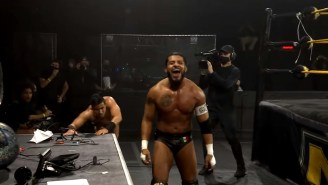Previously on NJPW: Naito and Hiromu retained their championships in Osaka, praise be to Wrestling God.
You can watch New Japan Pro Wrestling shows on their streaming service, NJPW World, which costs 999 yen (about 9 USD.)
You can keep up with With Spandex on Twitter and Facebook, follow our home site Uproxx on Twitter, and even follow me on Twitter @emilyofpratt. Don’t forget to share this column on Facebook, Twitter, or whatever social media you use! Also, leave a comment with your thoughts on the show and/or article! All feedback is appreciated and will help us keep up the NJPW coverage.
Adios, Tigre
This batch of New Japan Road shows took place over four consecutive nights in Tokyo’s Korakuen Hall and was way more stacked than these kinds of shows normally are. That’s still not that stacked, but we got two retirements and four title matches, and I think they all delivered. The rest of the cards generally weren’t bad to watch either, aside from at least one match per show that felt like a time-killer.
The February 19 card had the undercard that felt the most like filler, but Tiger Hattori’s final two matches as a referee were both entertaining in their own ways. How to give a referee the right retirement match is a trickier question to answer than how to book the same thing for a wrestler, but NJPW figured it out: they give him one retirement match full of shenanigans followed by one that’s just good quality.
The Bullet Club vs. Yano, Cabana, Ibushi, and Tanahashi match lets Hattori deal with BC causing problems and low blow the booker, and reminds us that the perfect way for a ref to go out is oddly by screwing up at his job. The main event (Goto, Ishii, and Okada vs. Naito, Shingo, and Sanada) features more memorable wrestling, especially the pre-title match action between Ishii and Shingo and the surprisingly awkward sequence between Naito and Okada that looks like they’re trying too hard to save inflicting damage on each other for their next singles match. Hattori getting to fist bump the cool kids for a second would be out of place in any other match, but here it’s a cute moment.
Replay Tiger Hattori Retirement Event (2/19) post-match videos on #njpwworld
Watch FREE▶https://t.co/iZhTKE4CC82/19 #njpw タイガー服部レフェリー引退記念大会 のバックステージコメントを #njpwworld で無料公開中▶https://t.co/CcdQ1XrpWA
.@TigerHattoriNY RETIREMENT CEREMONY pic.twitter.com/zvWlzux5Ec
— NJPW WORLD (@njpwworld) February 20, 2020
While his last matches as a ref showcase Tiger Hattori’s late-career character as a tiny grandpa official, his retirement ceremony – which has its cute moments too – is a reminder of how influential he’s been in his half-century career and what an interesting life he’s led. Japanese commentary talks about Hattori as a “gateway for foreign wrestlers” getting into New Japan, and Inoki mentions Hattori as one of New Japan’s past bookers. I imagine those outside of the business have only seen the tip of the iceberg of Hattori’s influence, which isn’t even officially gone from NJPW since, as he mentions backstage, he’s still under contract for the rest of the year. But though the real end of his time in New Japan hasn’t come yet, the end of Tiger Hattori’s referee career is still another sincere special event by a company that never seems to miss the mark when it comes to sending off people with whom they’re on good terms.
Best: The Students Become The Masters
[Replay ‘NEW JAPAN ROAD Night 1’ on February 20th, 2020]
6TH MATCH: IWGP Jr. HEAVYWEIGHT TAG TEAM CHAMPIONSHIP MATCH @njpwShowT & @njpwyohei_k vs. @azucarRoc & @taguchiryusuke!!
Watch on New Japan World▶︎https://t.co/CcdQ1X9P52#njpw #njpwworld #njroad pic.twitter.com/X3leWOgLj5— NJPW WORLD (@njpwworld) February 20, 2020
The first match with consequences in this series of shows is the IWGP Junior Tag Team Championship match on the 20th, in which Roppongi 3K successfully defends against the Mega Coaches. On the 19th, Taguchi completely sold me on the idea of a title change by pointing out that this would be his sixth reign as a Junior Heavyweight Tag Team Champion and Rocky’s ninth, but tragically, their pervert destiny was not to be.
Like the first match between these teams, R3K vs. Mega Coaches plays to Romero and Taguchi’s technical wrestling strengths, which I think fits the generational struggle premise of the match. We see Sho and Yoh have to play things a little smarter than usual in their straight-up wrestling rather than trying to thwart the cheating ways of Bullet Club or Suzukigun. The match felt long to me before the end, but overall it was engaging and different, with a lot of smart transitions and counters that showed off everybody’s range (and made me miss Kushida.)
Best: Souls And Skulls Collide
NEW JAPAN ROAD(2/20)を公開‼️
メインはNEVER無差別級選手権試合、王者@Takagi__Shingo 🆚 挑戦者・石井智宏‼️
まさに死闘💥‼️後楽園ホールは大熱狂‼️
この激闘を制するのは石井か⁉️それとも鷹木か⁉️
登録&視聴👉https://t.co/CcdQ1XrpWA#njpw #njpwwold #njroad pic.twitter.com/ZDNeqPbjVB— NJPW WORLD (@njpwworld) February 20, 2020
The night’s main event, Shingo Takagi vs. Tomohiro Ishii for the NEVER Openweight Championship, is a quality match in a very different style that also felt a little long at times. I don’t think Ishii-Takagi II had the electricity of their first match, which took place in the maximum hype environment of the G1 and the context of both of these men having top tier tournaments, but it was still really good.
This match is very much about Ishii and Takagi showing who’s tougher in an old school Japanese wrestling context as much as it is about winning. This sometimes makes it feel less urgent than most title defenses, but other times makes it feel way crazier, like that headbutt contest that made me grit my teeth out of anxiety. There’s a lot of no-selling of moves and then revealing the damage done by them later because it’s not that they don’t hurt; it’s the principle of the thing. The principle of sportsmanship is on display at points too, with Takagi showing he’s all about the honorable babyface champion lifestyle these days by throwing Ishii back in the ring right when he starts to get counted out. (Some of the match’s most fun moments are still when the champ completely eats shit due to Ishii being Ishii.)
Overall, it’s an entertaining and well-done match, and everything surrounding it shows Takagi doing what he said he was going to do as champion when he won the NEVER title. After insisting he’s “not the kind of guy who’s into that” (being cheered), he delivers his thesis statement: “Our spirits collided in this ring. That’s pro wrestling.” Right now, his in-ring actions are fitting those words, and it’s put the foundation in place for the best NEVER Openweight Championship reign in years.
Best: Send Out The Clowns
[Replay ‘NEW JAPAN ROAD Night 2’ on February 21st, 2020]
6TH MATCH: @taguchiryusuke, @ColtCabana & @YTR_CHAOS vs. @BUSHI_njpw, @151012EVIL & @Takagi__Shingo !!
Watch on New Japan World▶︎https://t.co/CcdQ1X9P52#njpw #njpwworld #njroad pic.twitter.com/fOYQeWpcCl— NJPW WORLD (@njpwworld) February 21, 2020
Los Ingobernables de Japon also took the NEVER Openweight 6-Man Tag Team Championship in a more serious wrestling direction earlier this year and might do so again, but on February 21, the trios belts return to joke territory and it works really well. Bushi, Evil, and Shingo obviously aren’t the legends of clownery that Yano, Cabana, and Taguchi are, but they make excellent straight men in comedy matches, especially because they don’t mind pulling off some trickery of their own. The title match mixes some quality wrestling with funny comedy spots, and Bushi completely owning Taguchi with the mist works really well as the finish. The Taguchi-Yano-Cabana-Japan-USA coalition might be done judging by how quickly Yano and Cabana threw Taguchi under the bus for their loss, but this trios match made me want to see more of both teams.
Best: Golden Ace Age
[Replay ‘NEW JAPAN ROAD Night 2’ on February 21st, 2020]
7TH MATCH: @ibushi_kota & @tanahashi1_100 vs. @TangaloaNJPW & @Tama_Tonga !!
Watch on New Japan World▶︎https://t.co/CcdQ1X9P52#njpw #njpwworld #njroad pic.twitter.com/6mPDO88cMG— NJPW WORLD (@njpwworld) February 21, 2020
The main event of this show, G.o.D. vs. Tanahashi and Ibushi, is the hottest IWGP Heavyweight Tag Team Championship match NJPW has had in a while, and for good reason. It’s two of New Japan’s biggest pure babyfaces versus two capable bad guys in a match with an outcome that’s hard to guess, even while watching the match.
Ibushi and Tanahashi always look like they should be able to beat Tama Tonga and Tanga Loa one-on-one, but the Guerrillas manage to control much of the match with their superior tag teamwork and willingness to cheat. Ibushi and Tanahashi win the match (and make it a lot more exciting in its third act) by using their top-notch singles wrestler skills to each counter the Super Powerbomb and their recently developed teamwork to get the win. By the time the bell rings, it feels like Ibushi and Tanahashi really achieved something, even though they were already way higher up in the NJPW power rankings than the tag champs.
As much as the star power of the new champs will help the tag title picture, the division benefits from having the longest line for a tag title shot there’s been in years. (Not all that many years, but definitely more than one or two!) FinJuice and G.o.D. have made it clear they want the belts back, and Dangerous Tekkers, powered by getting drunk together every day, are valuable new players in the scene. Taichi and Sabre vs. Ibushi and Tanahashi should be really good, and the main case against putting it on the Anniversary Show is so everyone can get more of the feud.
Best: Sundown On Monster Morning
[Replay ‘Manabu Nakanishi Retirement Event’ on February 22nd, 2020]
6TH MATCH: @nagata769, @cozy_lariat, @TENZAN323 & @nobitokun vs. Goto, Ibushi, Tanahashi & Okada !!
Watch on New Japan World▶︎https://t.co/CcdQ1XrpWA#njpw #njpwworld #njroad #NakanishiFinal #中西学引退 pic.twitter.com/wGRj5oQ0pL— NJPW WORLD (@njpwworld) February 22, 2020
The tour ends, along with Manabu Nakanishi’s pro wrestling career, with NJPW’s second retirement ceremony in four days. This one is even more affecting than the first because it’s for someone who actually wrestles in its corresponding wrestling match. After facing first Suzukigun, then the classic five-man L.I.J. lineup, then Bullet Club on the days leading up to Nakanishi’s final match, Nakanishi, Kojima, Nagata, and Tenzan take on the super-team of Okada, Tanahashi, Ibushi, and Goto in what’s framed as not just a retirement match for the former Olympian, but a kind of last stand for the Third Generation.
The friendship between the New Japan dads comes off as wholesome and genuine as them having that “New Japan dads” nickname, and it heightens the emotional impact of the match. Nakanishi and Nagata’s thirty-year relationship especially shines through Nagata making the most effort to be respectful to the retiree, and they have one of the most fun moments of the match when they psych out their opponents by faking out that Nakanishi has turned on his friend of thirty years in a monster rage.
Nakanishi’s last match feels more like Iizuka’s than Liger’s, in that you can feel that the crowd has made the conscious decision to buy into their role of treating the retiree like a star (though Nakanishi in his heyday was obviously a much bigger one than Iizuka.) The audience makes the Third Generation top guys again for the night, and the Nakanishi vs. Tanahashi sequences take things back to the 2000s, recalling when Nakanishi won the IWGP Heavyweight Championship from Tana. And watching the younger guys, especially Ibushi and Tanahashi, play heels for the night looks as fun for the audience as it does for the wrestlers. The energy in Korakuen Hall feels, through the screen, to be completely positive and sincere, and in the name of giving Nakanishi the best possible sendoff.
Challenge-mania!
Something interesting about NJPW putting so many title matches on these Road shows is how bare it seems to leave the March 3 Anniversary Show. Aside from Hiromu vs. Naito in the main event and either a heavyweight tag title defense or ZSJ vs. Moxley for the U.S. title (I’m guessing the former), it’s hard to guess what else of consequence will happen, and without this Road tour, they could have stacked that card with R3K vs. Mega Coaches and Shingo vs. Ishii. But NJPW did use this tour to set up a lot of potential matches and feuds for further in the future, especially for the New Japan Cup.
Last year’s New Japan Cup was all about a babyface stepping up to take down Jay White at Madison Square Garden, and this year’s NJPW landscape, still ravaged by Double Championship Fever, is much different. With The State of the Company not in jeopardy, a lot of people seem more focused on individual goals. We get promos about Jay White wanting revenge on Naito, Evil looking to elevate his career, FinJuice claiming that if either of them wins the Cup they’ll use it for a shot at the tag titles, Henare mostly wanting a shot at Shingo, Shingo just caring about the NEVER titles and fighting all the time, and Sho preemptively upset about not being included in all this. Depending on the brackets, there’s a potential for this year’s Cup to be pretty exciting.
Replay Manabu Nakanishi Retirement Event (2/22) post-match videos on #njpwworld
Watch FREE▶https://t.co/dN6NzhLZ5D2/22(土) #njpw 中西学 引退記念大会 のバックステージコメントを #新日本プロレスワールド で無料公開中▶https://t.co/CcdQ1XrpWA
.@WillOspreay pic.twitter.com/oQo9DqXret
— NJPW WORLD (@njpwworld) February 23, 2020
Will Ospreay is definitely a possible 2020 NJC winner now that he’s beaten ZSJ for the RevPro British Heavyweight Championship and announced he’ll be a heavyweight from now on. He warns people not to look down on him as a junior, but nobody is doing that because he’s been regularly beating top heavyweights for about the past year and a half.
Ospreay’s same-division interactions with Naito and Shingo on this tour are treated like they could lead to something. These are very over pairings that I can’t write about with any enthusiasm because experiencing Ospreay’s ugly gear and dye job and combination of weeaboo/theater kid vibes he has somehow retained into his late twenties gives me too severe of cringe chills and causes me to have to lay down for an hour! And last year’s BOSJ final was great, but Takagi and Ospreay’s work together on this tour just feels hyper-choreographed and way too aware that their singles match won the company’s fan poll for best of 2019.
Outside of the heavyweight division, we get a straightforward challenge for the IWGP Junior Tag Team Championship from Los Dos Peligrosos when Hiromu pins Yoh on February 22 after once again chopping off about half of his pec skin. Seeing these two teams back in action against each other in a more normal setting than that New Year’s Dash four-way is really fun, as is the build to Hiromu’s other big upcoming match, the Anniversary Show main event against Naito.
Naito and Hiromu messing with each other in the ring builds some extra hype for their match and supports their claims it won’t be a typical champ vs. champ exhibition bout. Meanwhile, their backstage interactions show off Naito and Hiromu’s found family big brother-little brother dynamic even more. These two are probably going to go feral in their match, but right now they feel like elementary school kids. (Naito’s tone while telling Hiromu “You have to play along with me! I played along with you!” crosses cultural and language barriers.)
I’m guessing we’ll find out what else the Anniversary Show will bring over the next few days, and whatever the rest of the card is, the main event is definitely going to be worth watching. I’ll see you back here to go over the best and the worst of it in March.

